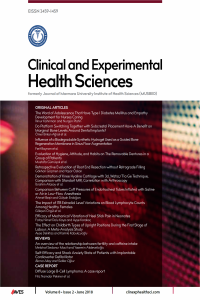Düşük Akımlı Anestezide Salin ve Hava ile Şişirilen Endotrakeal Tüp Kaf Basınçlarının Karşılaştırılması
Abstract
References
- Chapman J, Pallin D, Ferrara L, Mortell S, Pliakas J, Shear M, et al. Endotracheal tube cuff pressures in patients intubated before transport. Am J Emerg Med 2009; 27: 980-2
Comparison Between Cuff Pressures of Endotracheal Tubes Inflated with Saline or Air in Low-Flow Anesthesia
Abstract
Objective: Depending on the increase in inspired fractionated nitric oxide
fraction (FiN2O), cuff pressures in intubated patients are increased with diffusion
into endotracheal cuff during low-flow anesthesia (LFA) with nitrous
oxide (N2O). We compared pressures of air- and saline-inflated endotracheal
tube cuffs during LFA with N2O in our study.
Methods: We included 60 adult patients who were classified by the American
Society of Anesthesiologists as I/II in the study. After induction of anesthesia,
endotracheal cuffs of patients who were intubated were inflated
with air (Group A=30) and saline (Group S=30) to 25 cm water. Thus, two
equal randomized groups were separated. The anesthesia technique was
maintained with LFA and N2O. Endotracheal cuff pressures were continuously
measured with a pressure manometer, and inspired oxygen and N2O
levels and also 2 and 24 h after surgery for sore throat were recorded.
Results: There was no significant difference about demographic and intraoperative
data between the groups. Cuff pressures were significantly higher
in Group A than in Group S during all periods (p10 min=0.02, p<0.0001
for others). Group S had significantly higher values than Group A when
maximum cuff pressures were compared (37.60±3.16 vs. 29.96±3.34, respectively;
p<0.0001). There was a 51.9% positive correlation between cuff
pressure and FiN2O in Group A (r=0.519, p=0.048). Group Ahad significantly
higher level than Group S at postoperative 2 and 24 h when groups were
compared for postoperative sore throat without swallowing and swallowing
(p<0.05).
Conclusion: Under LFA with N2O, endotracheal cuff pressures during operation
and postoperative sore throat incidences in our study were significantly
higher in Group S than in Group A.
Keywords
References
- Chapman J, Pallin D, Ferrara L, Mortell S, Pliakas J, Shear M, et al. Endotracheal tube cuff pressures in patients intubated before transport. Am J Emerg Med 2009; 27: 980-2
Details
| Primary Language | English |
|---|---|
| Journal Section | Research Article |
| Authors | |
| Publication Date | June 15, 2018 |
| Submission Date | September 27, 2018 |
| Published in Issue | Year 2018 Volume: 8 Issue: 2 |

